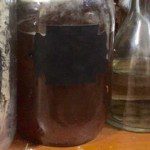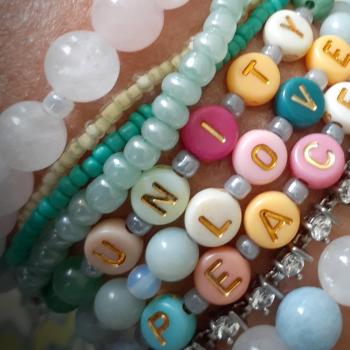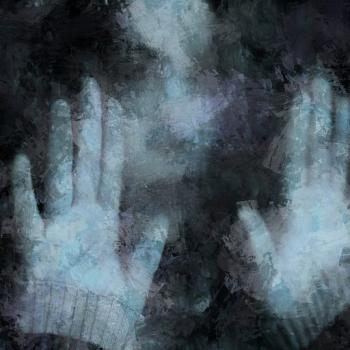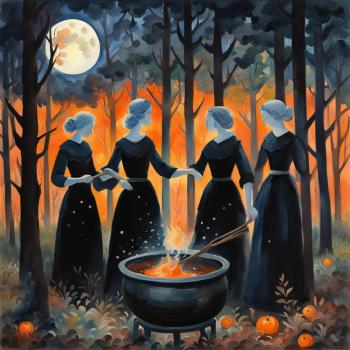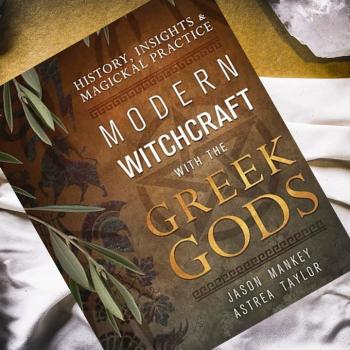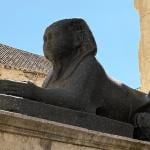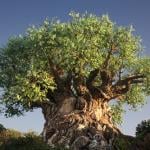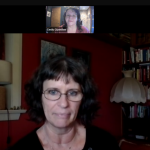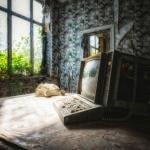At the end of last month, I had the opportunity to travel to Ireland as part of a sacred sites tour dedicated to the Morrigan which I co-facilitated with Stephanie Woodfield. This was a big deal for me because I cannot, generally speaking, afford to travel especially internationally, and I have wanted to go to Ireland for over twenty years. Being able to participate in this tour was significant, and thanks to Land Sea Sky Travel who were arranging the trip; it hit on all the sites I would have wanted to go see and many I didn’t know I’d want to go to until I was there. Important to me not only for the religious aspect of connecting to places associated with my Gods, but also because I have a passion for the old mythology and folklore itself, and I was driven to make the most of an opportunity to see the places I’d read about.

I am usually a very vocal advocate of connecting to the spirits – Gods, Other Crowd, and land spirits – where we are, of a very fingers-in-the-dirt spirituality. I still am a proponent of that, but there is also value¹ in seeing firsthand where the myths took place, of walking in the literal footsteps of the Gods and spirits. The backbone of our spirituality should be, I think, the daily things but that does not eradicate the numinous moments to be found in places that have been held sacred for millennia. And its one thing after all to read about something and another thing to altogether to directly experience it – I’ll certainly never think of souterrains the same way again.²
I was in Ireland for 10 days and it would be too long to recap all of it here. I have written a more personal blog about my experiences called “Muddy Boots; or setting my feet on the path before them” if anyone is interested in reading that aspect of my trip. What I’d like to look at here is what it was like to visit places where the myths that form the core of my religion actually took place. To stand on the ground the Gods were said to have stood on and to touch the earth and stones in those places. Because of the nature of the tour everywhere we went had its significance; some more well-known, some more obscure; some more moving and some less so. I want to highlight a few here that particularly stood out for me.
Rathcroghan – One of the main myth cycles in Irish mythology is the Ulster cycle, and a place which features often in that series of stories is Rathcroghan. Rathcroghan, part of the larger complex of Cruachan, includes the site of the royal palace of Queen Medb as well as Uaimh na gCat which is strongly associated with the Morrigan. Our group was lucky enough to be guided this particular day by Lora O’Brien who led us up the mound of Rathcroghan and later into the cave. Standing on the mound of Rathcroghan and envisioning the palace which once stood there was an amazing experience and more intense than I expected.
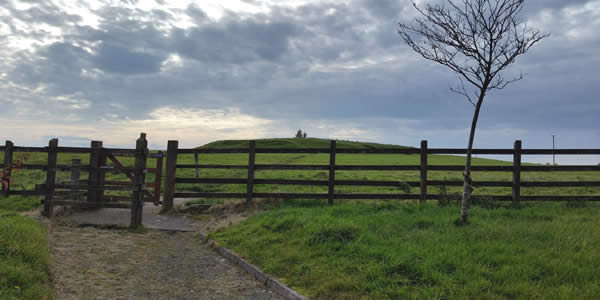
Although we had already visited Newgrange it was at Rathcroghan that I realized the power of being in a place you have read over and over about; of looking around and imagining that story taking place where you are actually standing. We were no longer simply talking about Medb but we were standing where her palace once stood, we were looking around at the same land that she would have looked around and seen. We weren’t just having an abstract discussion about the Morrigan when we went to Uaimh na gCat – we were touching the earth She is said to come and go from; we were ourselves going into the place which is called in the Dindshenchas: Her “fit abode.”
That tactile experience, that connection between the mental and the physical senses was a truly profound experience for me, as an American pagan who had not had that before on such a deep level. It is one thing where I live to see a historical site and know that a battle took place there, or a famous historical person lived there, but its something else to be somewhere that is so intrinsic to the story of a deity that I am closely connected to.
Tlachtga – I spent Samhain at Tlachtga, the Hill of Ward in Athboy. This is where, its said, the pagan Irish would gather to celebrate Samhain in the Iron Age with bonfires and ritual. For more than a decade I have re-enacted this ritual in my own home as part of my Druidic practices and I was excited this year to be participating in the public ritual on the Hill itself. I hadn’t anticipated though the emotional impact that would come with standing in a ritual surrounded by a crowd estimated at 2,000, able to see the distant fires lit on Teamhair [Tara] and knowing that everything we were doing was a modern interpretation and echo of practices rooted in thousands of years of history. That is a feeling that truly transcends words and I will take the experience and my gratitude for being able to be part of it with me for the rest of my life. You can watch this year’s Samhain Fire Festival on Tlachtga at the attached Youtube video, and if you stick it out to around 42 minutes you can listen to me offering a prayer to the aos sidhe for and to the gathered crowd.
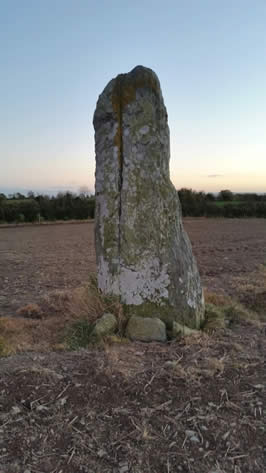
Cu Chulainn’s Stone – We also visited Cloch an Fhir Mhóir [stone of the big man] the standing stone which its said Cu Chulainn tied himself to as he was dying so that he would die on his feet. Our group gathered around it as dusk fell and I re-told the Aided Conculaind, the death tale of Cu Chulainn, gesturing to the stone and the land around us as I spoke. There is something deeply visceral – no pun intended – in telling that kind of story on the very ground that local lore says it occured on. In pointing to the stone itself as we talk about Cu Chulainn binding himself to it. Honestly as someone who has always described myself as neutral towards Cu Chulainn – I neither like nor dislike him – I was surprised by how moved I was to stand by the stone and tell the end of his story there. It was more moving than I expected to look around that empty field and envision that final battle, and ultimately the hero’s death.
Emhain Macha – I am dedicated to Macha, so perhaps it is no great surprise that one of the most moving places we visited was Emhain Macha, Macha’s eponymous territory, called Navan Fort today. As we walked the path out to the temple mound, Vyviane Armstrong of Land Sea Sky Travel talked about how local lore said that the path we were walking was the very race track that Macha had run while pregnant and pointed out a low stone which, she said, was where Macha was supposed to have given birth and died. Standing there and looking at that stone was a powerful moment for me, whether or not the story was true, because it drove home that this was one reason why this place was named for her. As we stood later in the area next to the main mound and I retold the story of Macha Mongruadh, pointing around us and talking about Macha drawing out the boundary of the fort I had another such moment where it ceased to be a simple story for me and became something more tangible and real. Not just a myth but an actual event grounded in the dirt and stones around me.
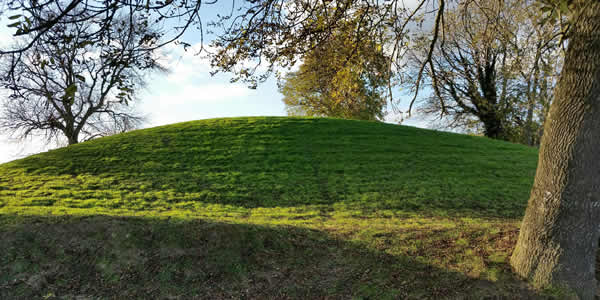
The trip was a life changing one for me and something I am still processing on deeper levels. I’ve already agreed to another Ireland trip with Land Sea Sky Travel in 2018 during Bealtaine, this one focused on southern Ireland and the mythology of that area. I am really excited about digging into the history and mythology of Munster and Cork, of Áine, Goibhniu, Donn, and the Cailleach and of making the same connections there that I made in Armagh, Roscommon, Louth, and Meath.
Endnotes:
- There is an inherent and undeniable privilege associated with being able to travel, and I don’t want to downplay that here. There will always be many reasons why going to sacred sites might be impossible for someone and I will never argue that such a thing is essential to anyone’s spirituality; however if it is possible there is value in it which should also be considered. (back)
- Tangential side story but the short version is I crawled through a souterrain at Knowth and it gave me a very different view of souterrains. Literally. (back)

Patheos Pagan on Facebook.
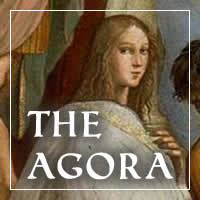
the Agora on Facebook
Irish-American Witchcraft is published bi-monthly on Tuesdays here on the Agora. Subscribe via RSS or e-mail!
Please use the links to the right to keep on top of activities here on the Agora as well as across the entire Patheos Pagan channel.


